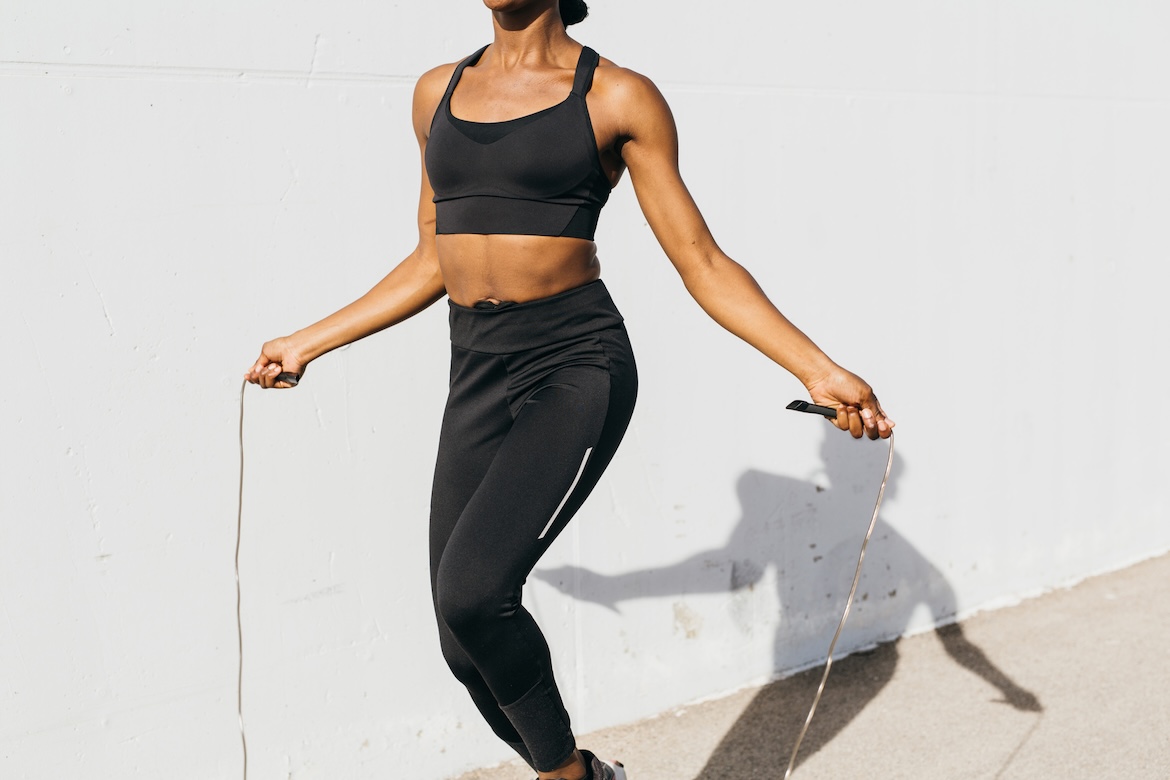Pee When You Jump? Here’s a Good Reason To Keep Trying
It's time to hop up.

Confession: I’ve never done Kegels. And yes, there were consequences to neglecting my pelvic floor muscles. As a mom of three, you can imagine what it looked like for me to do any kind of jumping. After a few bounces on the trampoline, I needed to change my pants.
When a running injury had me looking for alternatives, jumping rope stood out as the most time-efficient option. There are so many jump rope benefits! But I couldn’t jump for over a minute without annoying bladder leaks.
I could have sworn off jumping for good, but I decided to keep at it, hoping my pelvic floor would “toughen up.” Stationing my jumping zone near the bathroom, I persisted. Months later, I was able to do 20 to 30 minutes without a leak or potty break.
It seems as though jumping alone strengthened my pelvic floor, and I’m not alone. Is this a valid option for fellow Kegel haters? How exactly does the act of jumping keep you from peeing your pants?
We sought the expertise of physical therapists to share why jumping builds up those important pelvic floor muscles, and how you can endure the growing pains.
Why do pelvic floor muscles get weak?
Your pelvic floor muscles are a support system for your bladder, uterus, and bowels. These muscles hold in your pee when you aren’t on the toilet. Pretty important, and something we take for granted…until these muscles weaken.
Unfortunately, pelvic floor disorders are highly common in women. “Weak pelvic floor muscles can result from various factors,” says Kandis Daroski PT, DPT, pelvic health physical therapist for Hinge Health. Those include:
- Pregnancy and childbirth: The pelvic floor muscles can weaken during pregnancy due to the weight of the baby, and afterward due to the stretching of these muscles during childbirth.
- Menopause transition: Fluctuations in hormone levels, particularly during menopause, can lead to a weakening of the pelvic floor muscles.
- Aging: As people age, their muscles naturally weaken, including the pelvic floor muscles.
- Chronic constipation or straining during bowel movements: Straining during bowel movements can weaken the pelvic floor muscles over time.
- Chronic coughing: Conditions such as chronic bronchitis or asthma that lead to frequent coughing can strain the pelvic floor muscles due to excessive pressure being placed down on the muscles.
- Heavy lifting: Regularly lifting heavy objects without proper technique can strain the pelvic floor muscles.
- High-impact activities: If proper pelvic floor support techniques are not practiced, activities such as running, jumping, or vigorous exercise can stress the pelvic floor muscles.
Pelvic floor disorders are associated with pelvic organ prolapse, loss of bowel control, and even back injuries. The most common complaint is urinary incontinence.
So why do I pee when I jump?
Besides holding up your bladder, what does the pelvic floor have to do with peeing yourself? “The pelvic floor is part of a larger system of muscles that includes your diaphragm, abdominal, and spinal muscles. We commonly refer to this as the ‘core canister’,” explains Daroski.
“Leakage can be due to a problem with the bottom of this pressurized canister—pelvic floor muscle weakness. Leakage can also be related to problems with the other parts of the canister, the diaphragm, abdominal, and spinal muscles. Weakness or tension in these other areas can make it difficult for the pelvic floor to function properly which can lead to bladder leakage and other pelvic health symptoms.”
Essentially, your organs aren’t being held up as well as they should. The weight of sagging organs places pressure down below, making it difficult for your urinary sphincter (a muscular ring) to hold it all in.
Add in the force of gravity and the jostling effect of jumping, and BOOM, you’ve got a puddle in your pants.
How can jumping strengthen pelvic floor muscles?
Okay, so jumping can make you pee. But it can also activate and strengthen your pelvic floor.
“Research shows that regular physical activity can improve your overall health, including the function of your pelvic floor muscles,” says Jordan Miller, PT, DPT, PRPC, pelvic health specialist and pelvic health program manager for Athletico Physical Therapy.
“Jumping helps strengthen your lower extremity muscles (glutes and calves), which play a part in helping support your pelvis,” she says. “Jumping also improves your balance, awareness of your body in space, and your reaction time as you jump, which all serves to help you manage how your legs and trunk respond to forces acting on the pelvic region.”
While it seems counterintuitive to jump when you struggle with incontinence, jumping strengthens the pelvic floor—and you’ll be less likely to experience leakage.
What happens if you stop jumping?
Many women just avoid jumping altogether. But do we have to accept this as a part of aging? Daroski encourages you to keep trying.
“If someone skips jumping out of fear of leakage, they might be compromising the strength and reaction time of their pelvic floor muscles.”—Kandis Daroski, DPT
“In the realm of pelvic floor health, it’s not just about strength—it’s about endurance and agility too! When it comes to activities like jumping, your pelvic floor muscles need to react quickly to keep you leak-free,” she says. “But here’s the thing: If someone skips jumping out of fear of leakage, they might unknowingly be compromising the strength and reaction time of their pelvic floor muscles over time.”
So, use it or lose it. Daroski explains that skipping out on skipping could potentially worsen issues like urinary incontinence or pelvic organ prolapse because the muscles lose their ability to provide sturdy support to the bladder and surrounding structures.
“It’s essential to address concerns about leakage head-on and keep those pelvic floor muscles in tip-top shape with the right exercises and strategies.”
How can you deal with bladder weakness while jumping?
Want to conquer pee-free jump-roping? Miller suggests considering a few things first.
“Do you have any pre-existing pelvic floor conditions such as incontinence, pain, constipation, or pelvic organ prolapse? Can you perform a pelvic floor muscle contraction (aka Kegel) correctly, and also relax that contraction fully?”
If you think you may have pelvic floor dysfunction, seeking the advice of a pelvic health therapist is the best first step. If not, jump right in!
Besides jumping next to the bathroom or wearing incontinence underwear (two valid options!), how can you ease into jumping when you can’t stop peeing?
Daroski explains there are several ways to tackle this issue:
- Adjust technique during jumping: Engaging your pelvic floor muscles (doing a Kegel) before and during jumps can provide extra support to your bladder, minimizing the risk of leaks. Think of it as a little reminder to your pelvic floor before you take the jump.
- Make sure to land softly: When landing from a jump, land softly with bent knees to absorb the impact. Avoid landing with a jolt, which can put extra strain on the pelvic floor muscles and increase the likelihood of leakage.
- Work pelvic floor into your daily routine: Regularly practicing pelvic floor moves can strengthen those muscles over time, improving control and reducing the likelihood of leaks during high-impact activities like jumping.
- Strengthen your core: Strong core muscles can help support the pelvic floor and reduce pressure on the bladder.
As always, listen to your body. “If jumping is consistently leading to leakage that you are finding hard to control, consider exploring temporary alternative low-impact exercises that still get your heart pumping without putting undue stress on your pelvic floor. Continue working on strengthening and improving control of your pelvic floor muscles and work back to being able to jump,” says Daroski
Sounds like I may not be off the Kegel hook for good. My ever-changing body needs a variety of exercises to stay strong and age well. But for now, jumping is my pee-preventing jam—and I’m sticking with it!
What's Your Reaction?









![The HubSpot Blog's Marketing Leadership Report: How 720+ Brand Leaders Will Get Ahead in 2025 [+ How to Join Them]](https://www.hubspot.com/hubfs/Copy%20of%20The%20Future%20of%20Work%20is%20Flexible%20%5BImage%2c%20IG%5D%20%28598%20%C3%97%20398%20px%29%20%28595%20%C3%97%20400%20px%29%20%28517%20%C3%97%20517%20px%29.png)





























.png)












































